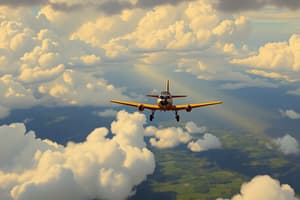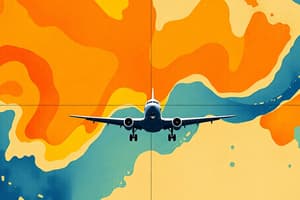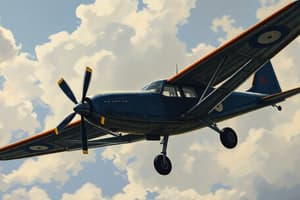Podcast
Questions and Answers
How far can you expect Class G airspace to extend above the surface of a mountain peak with an elevation of 14,128 feet MSL?
How far can you expect Class G airspace to extend above the surface of a mountain peak with an elevation of 14,128 feet MSL?
1,500 feet AGL (15,628 MSL)
What is the minimum distance from clouds that you must maintain while flying in Class G airspace when operating above 1,200 feet AGL but below 10,000 feet MSL?
What is the minimum distance from clouds that you must maintain while flying in Class G airspace when operating above 1,200 feet AGL but below 10,000 feet MSL?
500 feet below clouds, 1,000 feet above clouds, 2,000 feet horizontally from clouds
What is the floor of Class A airspace?
What is the floor of Class A airspace?
18,000 feet MSL
You can fly VFR in Class A airspace.
You can fly VFR in Class A airspace.
In which type of special use airspace might you find parachute jumping, glider towing, or high concentrations of student pilot training?
In which type of special use airspace might you find parachute jumping, glider towing, or high concentrations of student pilot training?
What type of special use airspace extends three nautical miles outward off the coast of the United States?
What type of special use airspace extends three nautical miles outward off the coast of the United States?
When can you fly in a prohibited area?
When can you fly in a prohibited area?
What is the normal ceiling of Class C airspace?
What is the normal ceiling of Class C airspace?
With reported visibility of one statute mile, you can land at a Class C airport using basic VFR weather minimums.
With reported visibility of one statute mile, you can land at a Class C airport using basic VFR weather minimums.
What minimum type of transponder is required when operating in Class C airspace?
What minimum type of transponder is required when operating in Class C airspace?
What is your first step when planning to land at a Class C airport?
What is your first step when planning to land at a Class C airport?
What are the dimensions of Victor airways?
What are the dimensions of Victor airways?
What are the VFR flight visibility and cloud clearance minimums when operating at 7,500 feet MSL in Class E airspace?
What are the VFR flight visibility and cloud clearance minimums when operating at 7,500 feet MSL in Class E airspace?
When flying VFR in Class E airspace, you must meet certification requirements.
When flying VFR in Class E airspace, you must meet certification requirements.
What is the primary difference between controlled and uncontrolled airspace?
What is the primary difference between controlled and uncontrolled airspace?
What are the six primary classes of airspace over the United States?
What are the six primary classes of airspace over the United States?
A standing NOTAM applies to events like major league baseball, NFL, or NCAA Division I football games.
A standing NOTAM applies to events like major league baseball, NFL, or NCAA Division I football games.
What does a national security area (NSA) designate?
What does a national security area (NSA) designate?
Which statement about the lateral boundary of Class D airspace is correct?
Which statement about the lateral boundary of Class D airspace is correct?
What is the minimum VFR flight visibility requirement in Class D airspace?
What is the minimum VFR flight visibility requirement in Class D airspace?
When must you contact the primary airport control tower when departing from a Class D satellite airport without a control tower?
When must you contact the primary airport control tower when departing from a Class D satellite airport without a control tower?
What is the normal vertical boundary of Class B airspace?
What is the normal vertical boundary of Class B airspace?
What is the VFR weather minimum for Class B airspace with regard to clouds?
What is the VFR weather minimum for Class B airspace with regard to clouds?
What is the purpose of a VFR corridor?
What is the purpose of a VFR corridor?
What equipment is required for VFR operations in Class B airspace?
What equipment is required for VFR operations in Class B airspace?
Prior to departing an airport in Class B airspace, what information should you provide to ATC?
Prior to departing an airport in Class B airspace, what information should you provide to ATC?
What minimum weather conditions are required for aircraft operating under special VFR clearances?
What minimum weather conditions are required for aircraft operating under special VFR clearances?
Under what plan might special security instructions be issued during a defense emergency?
Under what plan might special security instructions be issued during a defense emergency?
TFRs are established by NOTAMs that provide area dimensions and operating restrictions.
TFRs are established by NOTAMs that provide area dimensions and operating restrictions.
Which are requirements for operating under VFR near and within the Washington DC SFRA?
Which are requirements for operating under VFR near and within the Washington DC SFRA?
What should you do if you penetrate an area with security-related flight restrictions and are intercepted by U.S. military or law enforcement aircraft?
What should you do if you penetrate an area with security-related flight restrictions and are intercepted by U.S. military or law enforcement aircraft?
A military jet appears to your left, then performs an abrupt 90° turn without crossing your flight path. What does this mean and what is the correct response?
A military jet appears to your left, then performs an abrupt 90° turn without crossing your flight path. What does this mean and what is the correct response?
Flashcards are hidden until you start studying
Study Notes
Class G Airspace
- Class G airspace extends 1,500 feet AGL above mountain peaks; for a peak of 14,128 feet MSL, it reaches 15,628 feet MSL.
- Minimum cloud distance while flying in Class G above 1,200 feet AGL: 500 feet below, 1,000 feet above, and 2,000 feet horizontally from clouds.
Class A and B Airspace
- Floor of Class A airspace is at 18,000 feet MSL.
- VFR is not permitted in Class A airspace.
- Normal vertical boundary of Class B airspace is at 10,000 feet MSL.
- VFR weather minimums for Class B: clear of clouds.
Class C Airspace
- Normal ceiling of Class C airspace is 4,000 feet AGL.
- To land at a Class C airport with visibility at one statute mile, basic VFR minimums cannot be met.
- Required equipment for Class C airspace includes Mode C transponder.
- Establish two-way radio communication with ATC before entering Class C airspace.
Class D Airspace
- Minimum VFR flight visibility requirement in Class D airspace is three statute miles.
- When departing a Class D satellite airport without a control tower, contact the primary airport control tower as soon as practicable after takeoff.
Class E Airspace
- VFR visibility and cloud clearance minimums at 7,500 feet MSL in Class E: three statute miles visibility, 500 feet below clouds, 1,000 feet above, and 2,000 feet horizontally.
- No certification requirements for flying VFR in Class E airspace.
Special Use Airspace
- Activities like parachute jumping and glider towing may occur in Alert Areas.
- Warning Areas extend three nautical miles outward off the U.S. coast.
- Prohibited areas may only be entered when authorized by the controlling agency.
- TFRs (Temporary Flight Restrictions) apply to events like major league sports, preventing aircraft operations within three nautical miles of stadiums with over 30,000 seats.
National Security Areas
- Designated areas where pilots are requested to avoid flight for increased security, known as National Security Areas (NSA).
Victor Airways
- Dimensions of Victor airways are four nautical miles on either side of the airway centerline, from 1,200 feet AGL to just below 18,000 feet MSL.
Special VFR and ADIZ
- Special VFR clearances require minimum visibility of one mile and being clear of clouds.
- Special security instructions may be issued during defense emergencies under ADIZ (Air Defense Identification Zone).
Washington DC SFRA
- Within the Washington DC Special Flight Rules Area (SFRA), pilots must complete FAA Special Awareness Training and maintain a maximum speed of 230 knots between 30 and 60 nautical miles from DCA VOR.
Interception Procedures
- If intercepted by military or law enforcement aircraft while within security-related flight restrictions, follow their visual signals or radio communications until released.
Flight Communication
- Provide ATC with intended altitude and route before departing in Class B airspace.
- Utilize a two-way radio and Mode C transponder while operating in Class B airspace.
Class D Operational Procedures
- Lateral boundaries of Class D may include extensions for instrument procedures.
Studying That Suits You
Use AI to generate personalized quizzes and flashcards to suit your learning preferences.




